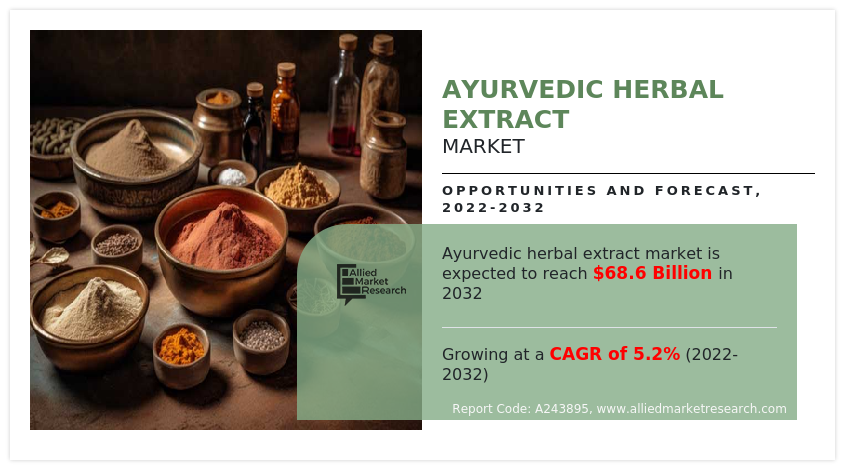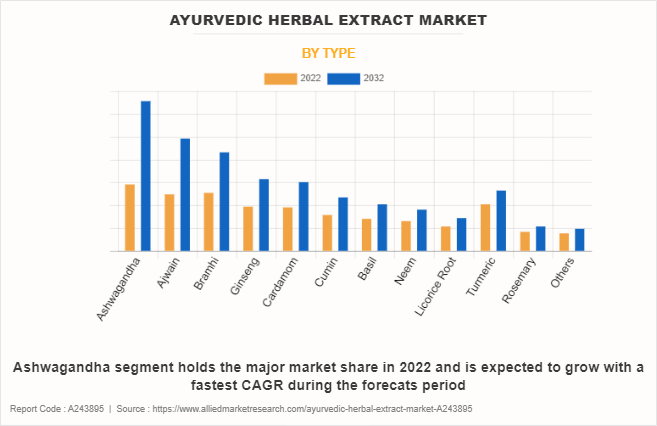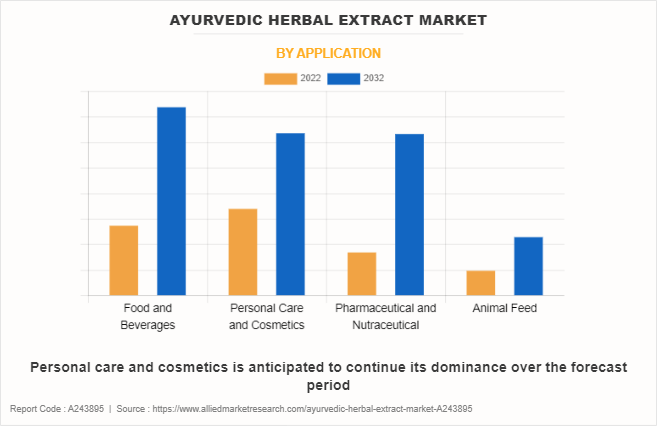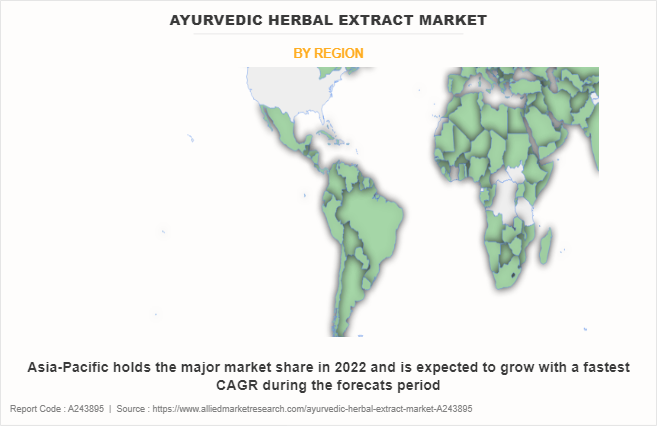Ayurvedic Herbal Extract Market Research, 2032
The global ayurvedic herbal extract market size was valued at $41.5 billion in 2022, and is projected to reach $68.6 billion by 2032, growing at a CAGR of 5.2% from 2022 to 2032. Ayurvedic herbal extracts are concentrated formulations derived from medicinal plants, following the principles of Ayurveda. These extracts capture the therapeutic properties of herbs through meticulous extraction processes, preserving their natural compounds. Widely used in traditional medicine, ayurvedic herbal extracts are gaining global recognition for their potential health benefits. These natural remedies are believed to promote overall well-being by addressing various ailments and imbalances in the body, aligning with the holistic approach of ayurvedic practices to enhance physical, mental, and spiritual health.

The freshly dried herbs are mixed with water or alcohol and processed further to extract the full flavor of the herb. Herbal extract refers to this extracted essence in liquid or dry form. Herbal extract contains all of the qualities of the herb, which are then utilized in its natural form or mixed with other herbs to boost its nutritional and beneficial contents.
The ayurvedic herbal extract market is witnessing substantial growth, driven by several major factors. The global demand for natural and plant-based products is on the rise, driven by an increase in consciousness about health & wellness. Consumers are actively seeking alternatives to synthetic ingredients, displaying an increase in interest in traditional and herbal remedies. A rise in R&D activities is contributing to innovations in extraction techniques, formulation methods, and overall product development within the herbal extract sector. Favorable regulatory frameworks in numerous countries are driving market expansion by ensuring adherence to safety, quality, and efficacy standards. In addition, technological advancements, such as improved extraction methods and analytical techniques, are enhancing the quality and consistency of herbal extracts. The market growth is further boosted by the traditional importance of herbal medicine in various cultures, along with growing consumer trust and acceptance. Therefore, these factors collectively drive the ayurvedic herbal extract market growth, creating new opportunities for manufacturers, suppliers, and consumers.
One of the major obstacles limiting the growth of the herbal extract industry is its high production costs. The primary difficulty with herbal extract is collecting and processing herbal constituents, which may be time-consuming and resource-intensive, resulting in increased manufacturing costs. For example, the extraction and purifying processes for uncommon or specialty plants are a major contributor to increased production costs. Furthermore, additional manufacturing factors such as labor, energy, and equipment all contribute to its higher production costs. Furthermore, some manufacturers are required to comply to stringent regulatory requirements such as Good Manufacturing Practices (GMP), which can drive up costs further. Therefore, these factors are anticipated to have an adverse impact on the market, limiting its expansion.
The ayurvedic herbal extract market demand is witnessing substantial growth, driven by the rising popularity of herbal medicine. As consumers increasingly embrace natural remedies, the demand for herbal extracts rises. Herbal medicine's holistic approach toward wellness and the perceived benefits of plant-based solutions contribute significantly to the market expansion. Consumers are increasingly preferring alternative remedies to numerous health conditions, which is boosting demand for herbal extracts. For example, Himalaya Herbals, offers a diverse selection of herbal products, including their Liv.52 liver care supplement made from natural extracts. Furthermore, numerous government organizations are becoming more aware regarding the importance of traditional medicine which is leading to an increase in adoption in healthcare systems. For example, the Indian government's Ministry of AYUSH promotes Ayurveda and traditional herbal treatments, stressing the benefits of herbal extracts such as Ashwagandha and Turmeric. All these factors are likely to have a favorable influence on the industry, creating an opportunity for the market expansion in the upcoming years. For instance, in June 2021, Vasu Healthcare Pvt Ltd., an Indian herbal manufacturer, introduced an innovative range of herbal supplements in the market. The product range was advertised as ‘Vasu Safe Herbs,’ which aids in the promotion of people's general health and well-being.
Segmental Overview
The ayurvedic herbal extract market segemntation on the basis of type, application, and region. By type, the market is divided into ashwagandha, ajwain, bramhi, ginseng, cardamom, cumin, basil, neem, licorice root, turmeric, rosemary, and others. By application, the market is classified into food & beverages, personal care & cosmetics, pharmaceutical & nutraceutical, and animal feed. By region, the market is analyzed across North America, Europe, Asia-Pacific, and LAMEA.
By Type
By type, the ashwagandha sub-segment dominated the market in 2022. Increased demand for dietary supplements, as well as increased awareness regarding the nutritional and medicinal advantages of ashwagandha, are likely to drive ashwagandha extract market growth. Increased consumer awareness about personal health & wellness is projected to be an important factor driving the ashwagandha segment growth during the forecast period. Global demand for ashwagandha is being driven by growing awareness regarding its potential health advantages. Growing consumer interest in herbal and alternative therapies is major factor driving up ashwagandha's demand. The market is additionally driven by the functional integration of ashwagandha into products by the pharmaceutical and nutraceutical industries. The market for ashwagandha is positively impacted by the global trend towards wellness and holistic health practices. The popularity of ashwagandha derives from its high adaptogen, which is well-known for its ability to reduce stress. The growing number of consumers, including new and repeat users, is driving the expansion of the global ashwagandha market. To increase the uses of ashwagandha, industry participants are spending money on R&D, which is driving the market expansion. These are predicted to be the major factors driving the Ayurvedic Herbal Extract Market Forecast period.

By Application
By application, the personal care & cosmetics sub-segment dominated the global ayurvedic herbal extract market share in 2022. In the personal care & cosmetics segment, ayurvedic herbal extracts emerge as a driving force in response to the rising demand for natural and sustainable ingredients. Consumers are increasingly prioritizing skincare and beauty products that align with their wellness values. Ayurvedic herbal extracts, rich in traditional healing properties, offer a compelling solution for formulators aiming to create products that resonate with this conscientious consumer base. These extracts, derived from ancient ayurvedic principles, not only cater to the desire for efficacy but also tap into the broader trend of embracing nature-based, eco-friendly alternatives in the personal care & cosmetics industry. Therefore, ayurvedic herbal extracts stand at the forefront of innovation, influencing and shaping the landscape of natural beauty and personal care products.

By Region
By region, Asia-Pacific dominated the global ayurvedic herbal extract market in 2022. Factors such as the wide availability of herbal plants, the age-old tradition of people using natural herbs, the therapeutic effect of herbal products, adoption of healthy lifestyle after pandemic, awareness about the harmful effects of synthetic ingredients, use of herbal cosmetics products, government policies, and business sustainability programs are expected to influence the demand for herbal extract in the region. Countries in Asia-Pacific, such as India and China, are expected to dominate the herbal extracts industry and have emerged as the leading exporters of some of the world's most valuable extracts, such as curcumin, ashwagandha, kale, and others. China and Japan have long been among the region's leading nutraceutical marketplaces. With growing usage of pharmaceutical goods and nutraceutical supplements in Japan, China, and other countries, the industry has seen major expansion.

Competitive Landscape
The key players profiled in this report include Nexira, Blue Sky Botanics, MartinBauer, Synergy, Döhler GmbH, The Biolandes Group, Kalsec Inc., Vidya Herbs Pvt. Ltd., International Flavors & Fragrances Inc., and Synthite Industries Ltd. Investment and agreement are common strategies followed by major market players. For instance, in 2021, Manipal Group, an India-based functional food and botanical ingredient provider, announced the opening of a new manufacturing facility specialized in the synthesis of herbal extracts. These nutraceutical components are used to make dietary supplements.
Impact of COVID-19 on the Global Ayurvedic Herbal Extract Industry
- The ayurvedic herbal extract industry faced significant challenges due to disruptions in the global supply chain caused by the COVID-19 pandemic. Lockdowns, restrictions, and logistical issues impacted the sourcing of raw materials, hindering production processes. Health & wellness became a top priority for consumers during the pandemic. While demand for immune-boosting ayurvedic products increased, other segments saw a temporary decline as consumers focused on essential needs.
- The pandemic led to an increase in awareness regarding the importance of immune health, leading to a surge in demand for ayurvedic herbal extracts known for their immune-boosting properties, creating new opportunities within the industry.
- The post-COVID-19 period has significantly impacted the global ayurvedic herbal extract industry, reshaped dynamics and driving notable changes. As health & wellness gained increased importance during the pandemic, there has been a surge in consumer interest in traditional and holistic approaches, including Ayurveda. This renewed focus on overall well-being has led to an increase in demand for ayurvedic herbal extracts across the globe.
Key Benefits for Stakeholders
- This report provides a quantitative analysis of the market segments, current trends, estimations, and dynamics of the ayurvedic herbal extract market analysis from 2022 to 2032 to identify the prevailing ayurvedic herbal extract market opportunities.
- The market research is offered along with information related to key drivers, restraints, and opportunities.
- Porter's five forces analysis highlights the potency of buyers and suppliers to enable stakeholders make profit-oriented business decisions and strengthen their supplier-buyer network.
- In-depth analysis of the ayurvedic herbal extract market segmentation assists to determine the prevailing market opportunities.
- Major countries in each region are mapped according to their revenue contribution to the global market.
- Market player positioning facilitates benchmarking and provides a clear understanding of the present position of the market players.
- The report includes the analysis of the regional as well as global ayurvedic herbal extract market trends, key players, market segments, application areas, and market growth strategies.
Ayurvedic Herbal Extract Market Report Highlights
| Aspects | Details |
| Market Size By 2032 | USD 68.6 billion |
| Growth Rate | CAGR of 5.2% |
| Forecast period | 2022 - 2032 |
| Report Pages | 290 |
| By Type |
|
| By Application |
|
| By Region |
|
| Key Market Players | Nexira, MartinBauer, Vidya Herbs Pvt. Ltd., Blue Sky Botanics, International Flavors & Fragrances Inc., The Biolandes Group, Dermapharm AG, Kalsec Inc., Döhler GmbH, Synthite Industries Ltd. |
The global ayurvedic herbal extract market size was valued at $41.5 billion in 2022, and is projected to reach $68.6 billion by 2032
The global Ayurvedic Herbal Extract market is projected to grow at a compound annual growth rate of 5.2% from 2022 to 2032 $68.6 billion by 2032
The key players profiled in this report include Nexira, Blue Sky Botanics, MartinBauer, Synergy, Döhler GmbH, The Biolandes Group, Kalsec Inc., Vidya Herbs Pvt. Ltd., International Flavors & Fragrances Inc., and Synthite Industries Ltd. Investment and agreement are common strategies followed by major market players.
By region, Asia-Pacific dominated the global ayurvedic herbal extract market in 2022.
Growing popularity of herbal medicine, Rising global demand for natural and plant-based products, Increase in consciousness about health & wellness
Loading Table Of Content...
Loading Research Methodology...



